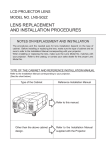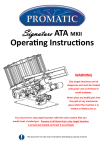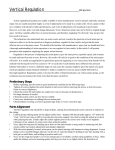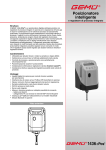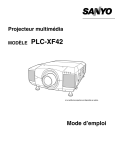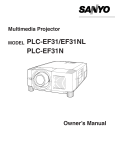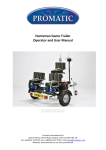Download Ranger Chondel User Manual
Transcript
Promatic International Ltd. Station Works, Hooton, South Wirral CH66 7NF, United Kingdom. Tel: +44 (0) 151 327 2220 (General) +44 (0) 1407 860800 (Sales) Fax: +44 (0) 151 3277075 E-mail [email protected] Website: www.promatic.co.uk Promatic Inc. 7803 West Hwy 116 Gower MO 64454 USA. Toll Free: 888.767.2529 Fax: 816.539.0257 E-mail: [email protected] Website: www.promatic.biz Ranger Chondel Version 2 August 2014 24 Operating Instructions Ranger Chondel - Clay target launcher WARNING Clay target launchers can be dangerous and must be treated with great care at all times to avoid accidents. Never place any bodily part into the path of any mechanical piece whilst the machine is in motion or likely to be so. Specifications: 300 target Carousel. Weight: 80 kg / 176 lbs Length: 800mm / 31½“ Width: 410mm / 16 “ Height: 1095mm / 43” You must treat a clay target launcher with the same caution that you would treat a loaded gun. Assume at all times that a clay target launcher is armed and loaded and treat it accordingly This document must be read in full before attempting to operate the machine Preface: Every effort has been made to ensure that the information contained within this manual is complete, accurate and up-to-date. Promatic International assumes no responsibility for errors beyond its control. Conventions used within this manual: Trap: Your Ranger Chondel Clay target launcher, commonly known as a clay trap and may be referred to in this manual as “The trap” or “The machine” Warnings & Cautions: Warning: This section contains instructions which, if ignored or carried out incorrectly, may result in risk of personal injury. Caution: This section contains instructions which, if ignored or carried out incorrectly, may result in malfunction or damage to the equipment or consumables. Note: This section contains additional information which the user may find useful, but is not essential to the operation of the product. 12v DC Power Source: This trap is designed to be powered from a 12v DC battery, it MUST NOT BE DIRECTLY CONNECTED TO MAINS AC POWER Battery: Where a trap is connected to any other suitable power source i.e. a Transformer - the relevant sections of instructions should still be observed, i.e. “Disconnect the battery” and applied to this or any other power source. EYE PROTECTION MUST BE WORN WHEN WORKING ON OR AROUND A CLAY TARGET LAUNCHER AS SMALL SHARP PIECES OF CLAY MAY BE EJECTED DURING NORMAL USE. 2 23 Understanding your new trap: (Guard has been removed for clarity in the side view) NOTES: Carousel Throwing Arm Roller Switch Motor & Gearbox Casting Plate Spring Finger Top Plate Knife edges Rear Pusher Let Down Ramp Thank you for purchasing your new Promatic Trap. If maintained properly it will give many years of trouble free service. Before proceeding any further, checks need to be made to ensure your Trap is in a safe state. When making these checks, stay well away from the Trap. As supplied, the Trap should be in Transit mode. Before proceeding any further check that this is the case. Transit mode is described on page 4. If this is not the case, the trap may be in safe mode as described on page 5. If the Trap does not appear to be in any of these two positions assume it is unsafe, even if the power source is dis-connected. Do not approach the Trap. Assume it could fire at any time. Follow the procedure on page 5 and ensure the Trap is disarmed. 22 3 Transit Mode Procedure - This is recommended for machine transportation. Warning: Stand at rear of machine only a) Disarm the machine by flicking the ARM/DISARM switch upwards towards the DISARM position and immediately releasing (long enough for the trap to fire, but not giving the machine a chance to rearm). The throwing arm should be pointing towards the front of the machine. The Gearbox block (A rectangular block attached to the gearbox shaft) should be in a position pointing towards the front of the machine. Push the ARM/DISARM switch momentarily in direction of DISARM/NUDGE just enough to allow the block past its forward pointing position. The gearbox block will now be pointing slightly up with the drive pin just above the gearbox shaft. If the block has gone too far, follow this procedure again until the desired position is achieved. b) Disconnect the power source from the machine. c) Adjust the spring to reduce the tension. d) The throwing arm can be pushed slowly, USING THE PALM OF THE HAND ONLY, around clockwise . e) As the throwing arm gets to the firing position (pointing directly to the back of the machine) the spring will take over, moving the arm onto the drive bolt on the Gearbox block. This will stop the arm and prevent it from firing. f) This is TRANSIT MODE. The arm is now locked between the drive bolt and the one-way bearing within the trap, it cannot move or release again until power is applied and the ARM/DISARM switch operated. Gearbox block Command cable E03V/CCCH 5 pin relay E09V/5PIN 5 amp fuse E10V/F05A 40 amp fuse E10V/F40A Toggle switch E11V/7430 Main shaft spacer D04N/SP18 Spare Parts List: For parts not listed please call Promatic or you local dealer / service agent or visit UK & ROW — www.promatic.co.uk USA — www.promatic.biz Drive pin View from right of Trap Mainshaft pin Direction of rotation of Throwing arm Gearbox shaft Mainshaft pin locked against Drive pin. Note that some detail has been removed for clarity. 4 21 Never approach the machine from the front or sides, Do not assume the trap is safe even without electrical power it may still be armed and can fire without power being applied. Motor & Gearbox M01V/63918 Read and understand this manual. It contains important instructions for the safe operation of the machine. Under no circumstances must an inexperienced operator be allowed to work with the machine. Main bearing set B00V/SET1 Connecting the battery: Rear pusher roller D04N/RN25 Ensure you are behind the machine, the ARM/DISARM switch is in the OFF position and it is otherwise safe to proceed. Connect the red cable to the Red (+) terminal and the black cable to the Black (-) Terminal. Ensure the terminal fasteners are tight and the charger has been removed. Disarming the machine (Safe mode). 1. Roller switch RN6/7200 Spring roller RN6/2630 2. To disarm the machine push the ARM/DISARM switch upwards to the DISARM position and immediately release (long enough for the trap to fire, but not giving the machine a chance to rearm). The throwing arm should be pointing towards the front of the machine. Turn the ON/OFF or switch (if fitted) to the OFF or position and disconnect the battery. Positioning the machine 1. Main spring S01Z/SHTR Backrail RCH/3440 2. 3. Clay Target Launchers must be situated on firm level ground in a position that will allow unrestricted access to rear of machine. There must be no obstructions to the path of the throwing arm. Ensure that the power supply can be easily disconnected and cables cannot become tangled in any part of the mechanism. Firing the machine (Ensure the range is clear at the front of the trap.) 1. Teal finger RN6/3500 Rear pusher spring S02Z/037D6 20 2. 3. Turn the ON/OFF or switch (if fitted) to the ON or position and set the ARM/DISARM switch to the ARM/LOAD position. The machine will move automatically and arm itself ready to launch a loaded clay. Press the FIRE button on the command cable to throw a clay. The machine will fire every time the FIRE button is pressed and will automatically rearm itself, until disarmed and switched off. When switched off, disconnect the power source. 5 ALWAYS disarm the machine before any, adjustment or maintenance. ALWAYS disconnect the battery after making the Trap safe. ALWAYS approach the Trap from the rear, NEVER from the front or sides and ONLY if the machine is disarmed . NEVER allow children or untrained persons to approach the machine. NEVER move an armed/loaded machine. REMOVE the main throwing spring before transport in a vehicle. BE AWARE of the fall zone of both broken and unbroken clays and that a change in wind direction will affect this. WARNING BEFORE ANY MACHINE ADJUSTMENTS Part of this procedure requires you to work very close to the trap - before proceeding be sure you understand and have practised the procedure for putting the trap into safe mode (this can be found on page 5 of this manual) and fully understand when the trap is safe and when it is not. Spare Parts List: This is a list of spares, but is not exhaustive. For parts not listed please call Promatic or you local dealer / service agent or visit www.promatic.co.uk Throwing arm RCH/2100/13 Friction strip RN6/2200 Clay sweeper A28S/PAJH Adjustment: Setting up knife edges Place a clay target on the top plate and slide it under the knife edges. Using a 10mm spanner/ wrench, adjust the height of the leading edge of both knife edges by moving the nuts on each side of the knife edge. When the correct height in reached, lock the nuts against each other. It is desirable to have the knife edges as close to the shoulder of the clay as possible but leaving sufficient clearance to allow for deviation in clay thicknesses. Spinning the clay will give a good average of the shoulder height. This height is factory set and should work ‘out of the box’. It is worth a quick check to ensure these settings match your brand of clays. It is important that the clay is not pinched but can move freely beneath the knife edges. A gap of around 0.5mm usually works well. If the shoulder height deviates, set to a greater clearance. Deflector holder CH/3650 Deflector plate (LGE) A28S/AXMR Deflector plate (SML) A28S/BWMT Cone spring E12V/BENCS Outer knife edges RN6/3150 Inner knife edge RN6/3250 Outer knife edge block RN6/3200 Inner knife edge block RN6/3300 Let down ramp FN6/3400 6 19 ALWAYS disarm the machine before carrying out loading, adjustment or maintenance. d) e) Check the Throwing arm timing relationship. If this relationship is incorrect the trap will definitely break clays when throwing. The timing can be adjusted to the diagram found on Page 10 in this manual. Finally, after all the above has been tried, as a check for inferior clays, slacken the main spring. Fire a few clays with the spring slack. This significantly reduces the stresses put into the clay during the firing process. If the clays break, this is a good indication that the clays themselves are sub-standard. It is also important that the knife edges have the correct clearance around the diameter of the clay and that they support the skirt of the clay above the knife edges for its entire travel along them. To set this, slacken the nuts holding the inner knife edge. Hold the clay against the inner two carousel bars and gently tap the knife edge until there is approx. 1mm clearance between the dome of the clay and the knife edge. Tighten the fixing bolts. 1mm 1mm 0.5mm 1mm 0.5mm 1mm Now hold the clay against the two outer carousel bars. Again gently tap the outer knife edge until there is approx. 1mm clearance between the dome of the clay and the knife edge. Tighten the fixing bolts. Refer Carousel bars to the illustrations. The procedures for adjusting the height of the knife edges and the clearance to the dome of the clay are best performed together. Care taken at this stage will result in fewer ‘no birds’ and many hours of trouble free use. Problems usually revolve around the clay pigeons themselves or the variation in their sizes between the different manufacturers. Poor maintenance and cleaning or physical damage caused during transportation of the machine are the other normal causes. Items that should be treated with great care include the throwing arm, casting plate and electrical box. 18 7 Adjustment: Setting Elevation Angle 3. The trap breaks clays Trajectory of clays can be set from Rabbit to near Teal mode. Loosen Elevation nut as shown, elevate to desired angle and firmly re-tighten nut. Check the loading procedure. a) Check that the clays are intact and free of chips and cracks before loading into the carousel. Discard damaged clays. b) With the trap switched off, rotate the carousel by hand until a clay feeds onto the casting plate. Remove this clay and check for chips and cracks. If found, remove the entire carousel and find a clay that has the thickest shoulder. This clay should slide easily beneath both knife edges as per the setup instructions on Page 6. If this is not the case, reset the knife edges using the same procedure. c) If the clay breaks on contact with the casting plate, check that the soft fall plate offers a degree of damping for the clay as it drops. By design, the soft fall plate should sit very slightly above the casting plate, and should assume a slightly domed shape. Check this and make adjustments if necessary. Note that the gap between it the soft fall plate and the casting plate is very small. If after adjustment the clays are still breaking it is likely that the clay is too soft and unsuitable for use. d) Check that there are no tight spots in any of the carousel pockets. Test this by taking a handful of clays and slide them up and down the length of the carousel pockets. If they are tight against any of the rails, reshape them to allow free movement. This can be made easier by using a lever such as the handle of a spanner. Elevation Nut Be aware that when making Elevation and Tilt adjustments, the Trap is likely to move suddenly. Support the weight of the machine from the top of the carousel when adjusting these settings. Adjustment: Setting the Tilt Angle The Trap can be tilted both to the left and right. Loosen Tilt adjustment bolts as shown. The desired tilt can be achieved by slackening one or other of the bolts and then tightening the other firmly onto the Trap base. If the clay is now dropping correctly onto the casting plate prior to firing, but the trap fires a broken clay, then the fault probably lies in the throwing cycle. Check the throwing cycle. a) Check the throwing arm for straightness, for pieces missing from the rubber/ plastic friction strip or any other physical damage to the arm. If the arm cannot be straightened then it should be replaced. A new friction strip can be fitted to an old arm if necessary . Tilt adjustment bolt b) Check for damage to the casting plate especially the front edge of the plate. Check for flatness, ensure that no screw heads protrude and that there are no other obstructions to the clay’s path. Correct faults as necessary. c) Check that the screw holding the throwing arm to the clamp block is tightened correctly. Tilt adjustment bolt 8 17 ALWAYS disarm the machine before carrying out loading, adjustment or maintenance. ALWAYS disarm the machine before carrying out loading, adjustment or maintenance. Mechanical Troubleshooting. Adjustment: Spring Tension 1. Carousel does not rotate Spring adjustment is always easier if the spring roller on the main shaft is at its rearmost position, this relieves the spring of a large proportion of it’s tension making adjustment much easier as well as reducing wear on the spring adjustment mechanism. To achieve this, first perform the Safe Mode Procedure (see page 5) to put the machine into safe mode and then nudge forward until the throwing arm projects forward from the front of the machine. At this point stop nudging and disconnect the battery. Loosen the spring adjustment nut. Check. a) The carousel pusher arm is not jammed. b) The pusher return spring is broken or missing. Replace if necessary. c) With the pusher arm withdrawn, the carousel should be free to rotate with a small amount of friction. This is adjusted by tensioning the lock nut against the blue plastic sleeve at the centre of the carousel. d) The carousel timing is correct ie. When the gearbox crank and connecting rod are in line at maximum extension, the rollers on the bottom of the carousel pusher arm are 1mm clear of the top plate at maximum travel. Adjustment can be made by slackening the clamp on the rear pusher shaft and resetting the rear pusher as above. Retighten the clamp before operating the trap. To increase the spring tension, move the Lock nut towards the coil spring and then tighten the Adjustment nut behind it. To reduce the spring tension, move the Adjustment nut away from the spring coil and tighten the lock nut behind it. 2. Sub standard targets are thrown a) If the clay flicks up in the air it is likely that the arm is bent down or the casting plate is bent up. This has the effect of pinching the clay causing irregular flight. Straighten the arm and/or reset the casting plate. If this is not possible, replace them as necessary. b) The clay has no distance — the throwing arm is probably bent upwards allowing the clay to pass beneath the arm. This loss of contact will significantly reduce the thrown distance and can also lead to broken clays. Straighten or replace the arm. c) The direction of the clays are inconsistent. This can be caused by a warped arm not holding the clay against the casting plate. In this case, straighten the arm and reset the height of the casting plate to give a gap between the friction strip on the arm and the shoulder of the clay of between 1mm and 1.5mm. Sometimes the thickness of the clay shoulder varies. Resetting the height of the casting plate in the same way as above will restore clay target consistency. 16 Adjustment nut Lock nut Important: leave 30mm (1 3/16”) thread length between lock nut and spring coil. Increasing spring tension up to full length of thread will seriously detriment the performance of the machine and will cause spring damage or failure. 9 Adjustment: Throwing arm timing A. Disarm the machine by flicking the ARM/DISARM switch upwards towards the DISARM position and immediately releasing (long enough for the trap to fire, but not giving the machine a chance to rearm). The gearbox block will now be pointing towards the front of the machine. B. Flick the ARM/DISARM switch upwards towards the DISARM position repeatedly until the gearbox block points towards the back of the machine put does not contact the throwing arm. This reduces the spring tension. C. Note the position of the opening in the hook (down) and remove the spring. D. With the spring removed, rotate the throwing arm until the mainshaft crank is pointing towards the front of the machine with the upper face perpendicular (90°) to the front edge of the mainframe. See Diagram 1 below. E. On the other side of the machine, loosen the throwing arm clamp block bolt until the throwing arm will move around the mainshaft. Rotate the throwing arm anti-clockwise (this is so the mainshaft is held by the one-way bearing and doesn’t move) until the throwing arm points roughly towards the back of the machine and upper edge of the throwing arm clamp block is parallel with the top edge of the frame immediately behind it. See Diagram 2 below. F. G. Making sure both the mainshaft crank and the throwing arm are in the positions described, firmly tighten the throwing arm clamp block bolt. The arm timing is now complete. Replace the spring paying attention to the orientation of the hook. See page 4. Diagram 1. 4. Machine cocks, but will not fire on command cable button. (a) Either the connections, cable or command push button are faulty. Disconnect the Hirschman connector on the command cable. At the Hirschman connector on the trap, short out pins 2 & 3. If the trap does not fire then there is a broken wire in the cable or a bad connection in the hirschmann connector or in the control box. (b) If the trap does fire then reconnect the command cable, remove the cover on the push button box and short across the two spade connectors. If the trap fires then the push button is faulty. If the trap does not fire - then there is a broken wire in the command cable or a bad connection in the hirschmann connector. 5. Trap fires by itself! (a) Disconnect the command cable and switch the trap back on. If the trap cocks normally - then the command cable is damaged or shorted out. Alternatively, the push button switch is stuck in or faulty. (b) If the trap continues to fire - then check the arm to crank timing relationship as described on page 10 in this manual. If the above relationship is correct then, after having put the trap into the disarmed/safe position, move the roller limit switch up along the slotted bracket to its maximum. If the machine now cocks normally - then move the limit switch back to within 5mm of its original position. If the trap now fires by itself again then move the switch to 10mm of its original position and so on until the trap cocks normally under all conditions. (c) If the machine still fires by itself - check if the relay contacts have stuck together, and if so replace. If the relay operates correctly, but the trap still fires by itself, then the roller limit switch is faulty and should be replaced. Diagram 2. Parallel Clamp block bolt 10 ALWAYS disarm the machine before any loading, adjustment or maintenance. ALWAYS load clays from rear and ONLY if the machine is disarmed and safe. NEVER approach the machine from the front or sides. ALWAYS from the rear. NEVER allow children or untrained persons to approach or touch the machine. NEVER move an armed/loaded machine. ALWAYS disarm and disconnect battery. REMOVE the main throwing spring before transport in a vehicle. BE AWARE of the fall zone of both broken and unbroken clays and that a change in wind direction will affect this. 15 ALWAYS disarm the machine before carrying out loading, adjustment or maintenance. ALWAYS disarm the machine before carrying out loading, adjustment or maintenance. Electrical Troubleshooting. 1. Machine does not cock (i.e. come to the loaded position). (a) Check the battery is charged and that the connections are clean and tight. (b) Check the toggle switch is in the down (ON) position. (c) 2. Check the Throwing arm is clear of the Roller switch under the Casting plate. If not, then press toggle switch up to nudge the Arm around until it is clear, then switch it back down to the ON position. During this procedure it is possible the machine will fire. Adjustment: Spring Finger Loosen the nut holding the Spring finger. Position the Spring finger with the spring pointing directly towards the lower bolt holding the back rail. (See illustration). Align spring with bolt Machine still does not cock. (a) Check all connections are tight including those inside the electrical box. Check for broken wires and damaged connections. (b) If there are no broken connections (battery connected, all switches on) press toggle up to “NUDGE”, listen and watch for the 12v relay operation in the control box. (c) If the relay operates but the motor does not turn - short across the 2 large contacts on the relay with a screw driver or piece of wire. (These are the two terminals with red wires connected to them). If the motor does not turn - then the motor is suspect. If the motor does turn - then the relay is faulty. Contacts may be dirty or worn out. (d) If the relay does not operate – check the fuse has not blown. Replace fuse if it has blown and try again. (e) If the motor does not turn - then short the brown wire to the yellow/green wire on the back of the toggle switch with the switch in the “NUDGE” position. If the relay operates and the motor turns then the toggle switch is faulty. If the relay still does not operate, then it’s the relay that is faulty. 3. Machine runs in “NUDGE” position, but not in “ON” position. If the arm is clear of the Roller Switch then the Roller Switch may be faulty. Check that the roller arm is not seized. If so, strip, clean and re-assemble. Otherwise replace the Roller Switch. 14 Adjustment: Roller Switch Loosen both wing nuts and slide the roller switch so that the slot revealed measures 10mm. (See illustration). The gap is measured between the end of the slot and the body of the wing nut. 11 ALWAYS disarm the machine before carrying out loading, adjustment or maintenance. Adjustment: Teal Fingers The Trap has 3 teal fingers fitted to the inside of the outer guard plate. The Teal finger nearest to the throwing arm should be positioned so it is resting on the casting plate pointing towards the centre of the spring finger (approx). The other 2 should be aligned so that the tips of each are in line with the inside edge of the backrail. Teal fingers This diagram shows the adjustment of the nuts and the affect it has on the deflector plate. Note that the clay should be held mid way across the dome. If not, adjust the spring finger until it is. Note that some parts have been removed from the illustration for clarity. Adjustment: Switching from Standards to Rabbits (USA models only) Backrail Adjustment: Deflector Plate The deflector plate is adjusted using the 3 nuts as shown in the illustration to the right. The outer 2 nuts are used for Standard clays. The centre nut is used for Rabbit clays. When setting the deflector plate for Standard clays, adjust the 2 nuts until the clay is just held against the casting plate with no gaps. The clay should be held across the centre of the dome. Ensure that the machine is in the DISARMED/SAFE position and that the battery is disconnected. Remove the outer guard by un-doing the 19mm nylock nut and the two 8mm wing nuts. Remove the standard throwing arm and replace with the Rabbit throwing arm. The arm is attached to its mounting block with one bolt, a 19mm or 3/4” spanner will be required. Do not move the mounting block position on the main shaft or machine timing will be lost and have to be reset. After fitting the arm, refit the outer guard. The clay deflector will now need to be adjusted. This is done by un-winding the three lower horizontal 10mm nylock nuts on the side of the outer guard.. By loosening these three nuts the spring loaded deflector is pushed closer to the clay. This is necessary as the thinner Rabbit clays would fall out the bottom of the machine if the deflector was left set for Standard clays. Adjust the three nuts enough so that when a Rabbit clay is loaded the deflector supports it and holds the clay against the throwing plate. If the clay is to be loaded the upside down, spacers (supplied) need to be fitted beneath the knife edge blocks and a second carousel washer (supplied) fitted onto the carousel shaft. The knife edges will need to be reset, see page 4. When setting up for Rabbit clays, Unscrew the 2 outer nuts, then adjust the centre nut until the Rabbit clay is just held in the same way. This is usually done by unscrewing the nut allowing the springs to extend the deflector plate further towards the casting plate. Once set the centre nut will probably never need re-adjusting. Move between Rabbit and Standard clays simply by adjusting the 2 outer nuts. (Refer to ‘Switching from Standards to Rabbits on Page 13). 12 Prepare the machine for operation and fill with Rabbit targets before reconnecting the battery. Take care to ensure they are loaded correctly! 13















